wukong搜索引擎源码解读
转自:https://ayende.com/blog/171745/code-reading-wukong-full-text-search-engine
I like reading code, and recently I was mostly busy with moving our offices, worrying about insurance, lease contracts and all sort of other stuff that are required, but not much fun. So I decided to spend a few hours just going through random code bases and see what I’ll find.
I decided to go with Go projects, because that is a language that I can easily read, and I headed out to this page. Then I basically scanned the listing for any projects that took my fancy. The current one is Wukong, which is a full text search engine. I’m always interested in those, since Lucene is a core part of RavenDB, and knowing how others are implementing this gives you more options.
This isn’t going to be a full review, merely a record of my exploration into the code base. There is one problem with the codebase, as you can see here:

All the text is in Chinese, which I know absolutely nothing about, so comments aren’t going to help here. But so far, the code looks solid. I’ll start from the high level overview:
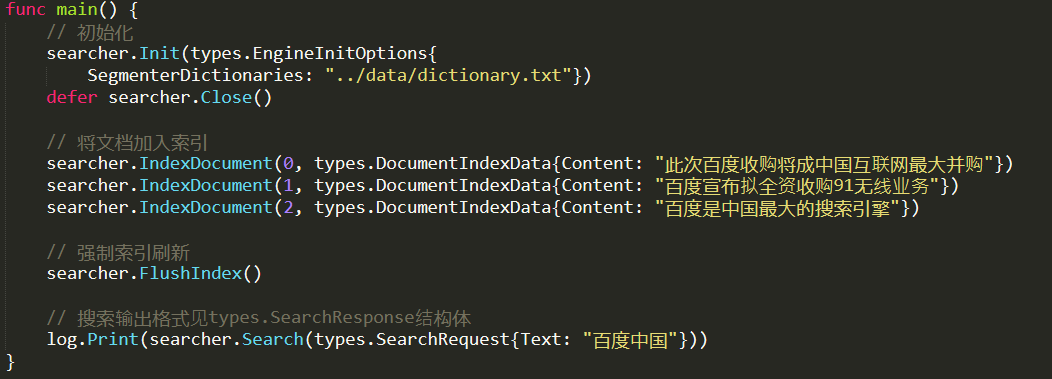
We can see that we have a searcher (of type Engine), and we add documents to it, then we flush the index, and then we can search it.
Inside the engine.Init, the first interesting thing is this:

This is interesting because we see sharding from the get go. By default, there are two shards. I’m sure what the indexers are, or what they are for yet.
Note that there is an Indexer and a Ranker for each shard. Then we have a bunch of initialization routines that looks like so:
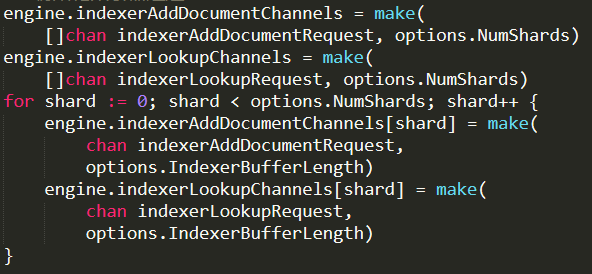
So we create two arrays of channels (the core Go synchronization primitive), and initialize them with a channel per shard. That is a pretty standard Go behavior, and usually there is a go routine that is spinning on each of those channels. That means that we have (by default) two “threads” for adding documents, and two for doing lookups. No idea what either one of those are yet.
There is a lot more like this, for ranking, removing ranks, search ranks, etc, but that is just more of the same, and I’ll ignore it for now. Finally, we see some actions when we start producing threads to do actual works:
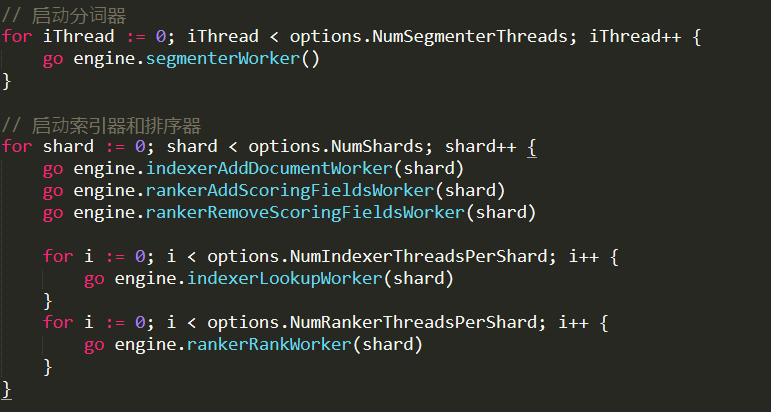
As you can see, spin off go routines (which will communicate with the channels we already saw) to do the actual work. Note that per shard, we’ll have as many index lookup and rank workers as we have CPUs.
There is an option to persist to disk, using the kv package, this looks like this:
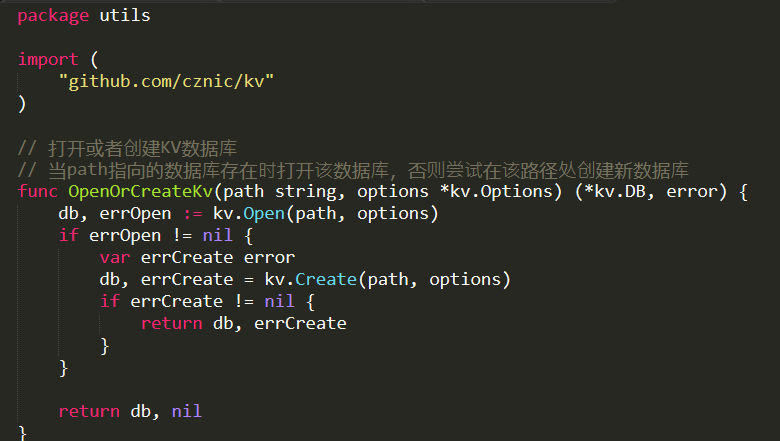
On the one hand, I really like the “let us just import a package from github” option that go has, on the other hand. Versioning control has got to be a major issue here for big projects.
Anyway, let us get back to the actual hot path I’m interested in, indexing documents. This is done by this function:
 a
a
Note that we have to supply the docId externally, instead of creating it ourselves. Then we just hash the docId and the actual content and send the data to the segmenter to do work. Currently I think that the work of the segmenter is similar to the work of the analyzer in Lucene. To break apart the content to discrete terms. Let us check…

this certainly seems to be the case here, yep. This code run on as many cores as the machine has, each one handling a single segmentation request. Once that work is done, it is sent to another thread to actually do the indexing:
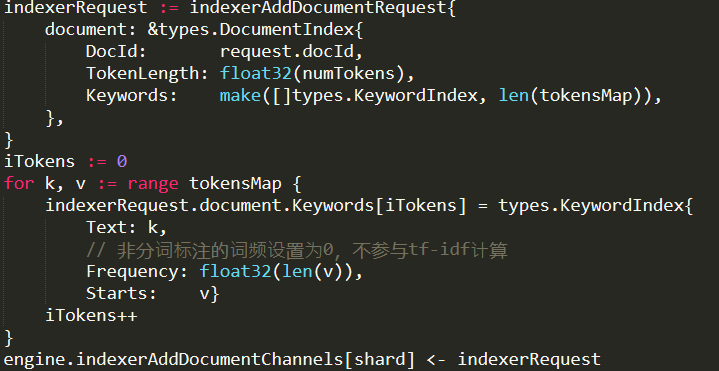
Note that the indexerRequest is basically an array of all the distinct tokens, their frequencies and the start positions in the original document. There is also handling for ranking, but for now I don’t care about this, so I’ll ignore this.
Sending to the indexing channel will end up invoking this code:

And the actual indexing work is done inside AddDocument. A simplified version of it is show here:
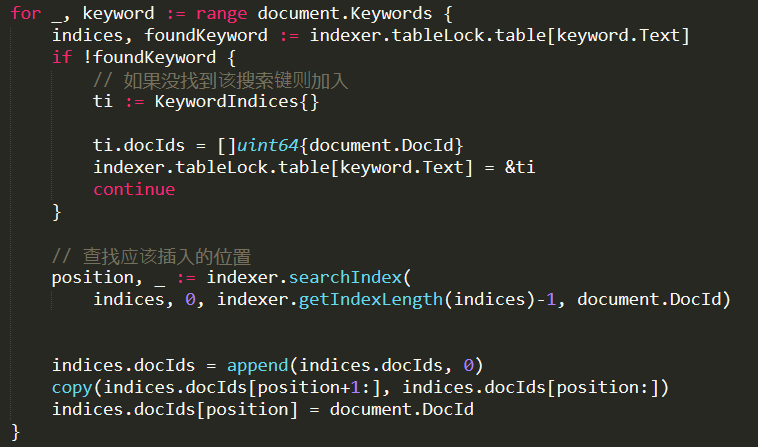
An indexer is protected by a read/write mutex (which explains why we want to have sharding, it gives us better concurrency, without having to go to concurrent data structures and it drastically simplify the code.
So, what is going on in here? For each of the keywords we found on the document, we create a new entry in the table’s dictionary. With a value that contains the matching document ids. If there are already documents for this keyword, we’ll search for the appropriate position in the index (using simple binary search), then place the document in the appropriate location. Basically, the KeywordIndices is (simplified) Dictionary<Term : string , SortedList<DocId : long>>.
So that pretty much explains how this works. Let us look at how searches are working now…
The first interesting thing that we do when we get a search request is tokenize it (segmentize it, in Wukong terminology):

Then we call this code:
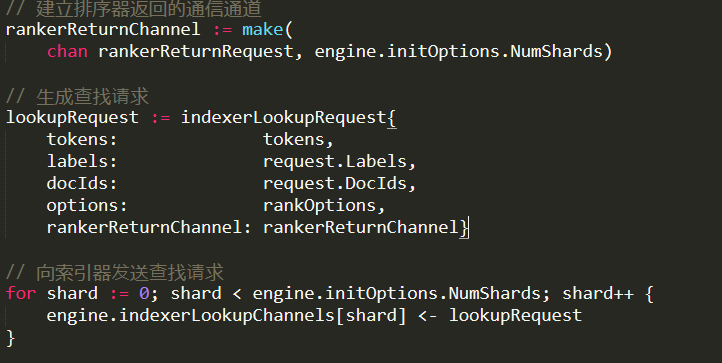
This is a fairly typical Go code. We create a bounded channel (that has a capacity as the same number of the shards), and we send it to all the shards. We’ll get the reply from all of the shards, then do something with the results from all the shards.
I like this type of interaction because it is easy to model concurrent interactions with it, and it is pervasive in Go. Seems simpler than the comparable strategies in .NET, for example.
Here is a simple example of how this is used:

This is the variant without the timeout. And we are just getting the results from all the shards, note that we don’t have any ordering here, we just add all the documents into one big array. I’m not sure how/if Wukong support sorting, there was a lot of stuff about ranking earlier in the codebase, but that doesn’t seem to be apparent in what I saw so far, I’ll look at it later. For now, let us see how a single shard is handling a search lookup request.
What I find most interesting is that there is rank options there, and document ids, which I’m not sure what they are used for. We’ll look at that later, for now, the first part of looking up a search term is here:
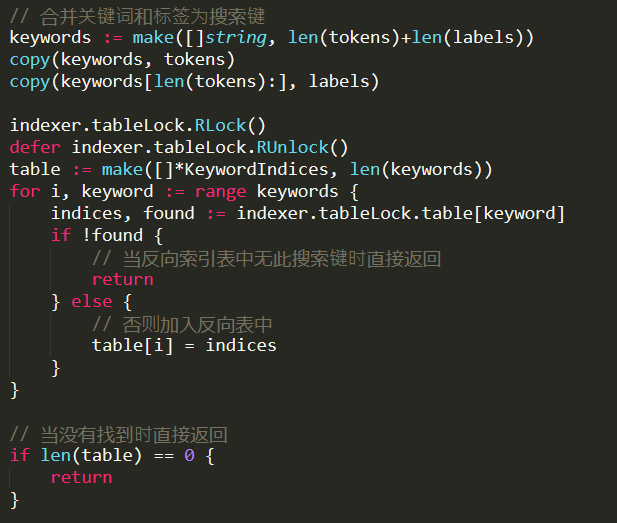
We take a read lock, then look at the table. We need to find entries for all the keywords that we have in the query to get a result back.
This indicates that a query to Wukong has an implicit AND between all the terms in the query. The result of this is an array with all the indices for each keyword. It then continues to perform set intersection between all the matching keywords, to find all the documents that appear in all of them. Following that, it will compute the BM25 (a TF-IDF function that is used to compute ranking). After looking at the code, I found where it is actual compute the ranking. It is doing that after getting the results from all the shards, and then it is going to sort them according to their overall scores.
So that was clear enough, and it makes a lot of sense. Now, the last thing that I want to figure out before we are done, is how does Wukong handles deletions?
It turns out that I actually missed part in the search process. The indexer will just find the matching documents, but their BM25 score. It is the ranker (which is sent from the indexer, and then replying to the engine) that will actually sort them. This gives the user the chance to add their own scoring mechanism. Deletion is actually handled as a case where you have nothing to score with, and it gets filtered along the way as an uninteresting value. That means that the memory cost of having a document index cannot be alleviated by deleting it. The actual document data is still there and is kept.
It also means that there is no real facility to update a document. For example, if we have a document whose content used to say Ayende and we want to change it to Oren. We have no way of going to the Ayende keyword and removing it from there. We need to delete the document and create a new one, with a new document id.
Another thing to note is that this has very little actual functionality. There is no possibility of making complex queries, or using multiple fields. Another thing that is very different from how Lucene works is that is runs entirely in memory. While it has a persistent option, that option is actually just a log of documents being added and removed. On startup, it will need to go through the log and actually index all of them again. That means that for large systems, it is going to be a prohibitly expensive startup cost.
All in all, that is a nice codebase, and it is certainly simple enough to grasp without too much complexity. But one need to be aware of the tradeoffs associated with actually using it. I expect it to be fast, although the numbers mentioned in the benchmark page (if I understand the translated Chinese correctly) are drastically below what I would expect to see. Just to give you some idea, 1,400 requests a second are a very small number for an in memory index. I would expect something like 50,000 or so, assuming that you can get all cores to participate. But maybe they are counting this through the network ?
wukong搜索引擎源码解读的更多相关文章
- SDWebImage源码解读之SDWebImageDownloaderOperation
第七篇 前言 本篇文章主要讲解下载操作的相关知识,SDWebImageDownloaderOperation的主要任务是把一张图片从服务器下载到内存中.下载数据并不难,如何对下载这一系列的任务进行设计 ...
- SDWebImage源码解读 之 NSData+ImageContentType
第一篇 前言 从今天开始,我将开启一段源码解读的旅途了.在这里先暂时不透露具体解读的源码到底是哪些?因为也可能随着解读的进行会更改计划.但能够肯定的是,这一系列之中肯定会有Swift版本的代码. 说说 ...
- SDWebImage源码解读 之 UIImage+GIF
第二篇 前言 本篇是和GIF相关的一个UIImage的分类.主要提供了三个方法: + (UIImage *)sd_animatedGIFNamed:(NSString *)name ----- 根据名 ...
- SDWebImage源码解读 之 SDWebImageCompat
第三篇 前言 本篇主要解读SDWebImage的配置文件.正如compat的定义,该配置文件主要是兼容Apple的其他设备.也许我们真实的开发平台只有一个,但考虑各个平台的兼容性,对于框架有着很重要的 ...
- SDWebImage源码解读_之SDWebImageDecoder
第四篇 前言 首先,我们要弄明白一个问题? 为什么要对UIImage进行解码呢?难道不能直接使用吗? 其实不解码也是可以使用的,假如说我们通过imageNamed:来加载image,系统默认会在主线程 ...
- SDWebImage源码解读之SDWebImageCache(上)
第五篇 前言 本篇主要讲解图片缓存类的知识,虽然只涉及了图片方面的缓存的设计,但思想同样适用于别的方面的设计.在架构上来说,缓存算是存储设计的一部分.我们把各种不同的存储内容按照功能进行切割后,图片缓 ...
- SDWebImage源码解读之SDWebImageCache(下)
第六篇 前言 我们在SDWebImageCache(上)中了解了这个缓存类大概的功能是什么?那么接下来就要看看这些功能是如何实现的? 再次强调,不管是图片的缓存还是其他各种不同形式的缓存,在原理上都极 ...
- AFNetworking 3.0 源码解读 总结(干货)(下)
承接上一篇AFNetworking 3.0 源码解读 总结(干货)(上) 21.网络服务类型NSURLRequestNetworkServiceType 示例代码: typedef NS_ENUM(N ...
- AFNetworking 3.0 源码解读 总结(干货)(上)
养成记笔记的习惯,对于一个软件工程师来说,我觉得很重要.记得在知乎上看到过一个问题,说是人类最大的缺点是什么?我个人觉得记忆算是一个缺点.它就像时间一样,会自己消散. 前言 终于写完了 AFNetwo ...
随机推荐
- linux logrotate配置
对于Linux 的系统安全来说,日志文件是极其重要的工具.系统管理员可以使用logrotate 程序用来管理系统中的最新的事件,对于Linux 的系统安全来说,日志文件是极其重要的工具.系统管理员可以 ...
- 货物搬运(move)
货物搬运(move) 题目描述 天地无情人有情,一方有难八方支援!汶川大地震发生后,灾区最紧缺的是救灾帐篷,全国各地支援的帐篷正紧急向灾区运送.假设围绕纹川县有环行排列的n个救灾帐篷的存储点,每个存储 ...
- manecher
#include<cstdio> #include<cstring> #include<iostream> #include<algorithm> us ...
- linux安装安卓开发工具android studio
http://www.android-studio.org/ http://android-studio.org/index.php/docs/guide 最近要接触android编程,本来想装ecl ...
- stm32 RAM分配及占有(转)
源:http://blog.chinaunix.net/uid-26921272-id-4550126.html 一个小的项目,在测试时间和产品量稍微大一些之后,出现了一些莫名其妙的非逻辑错误的Bug ...
- hdu-oj 1874 畅通工程续
最短路基础 这个题目hdu-oj 1874可以用来练习最短路的一些算法. Dijkstra 无优化版本 #include<cstdio> #include<iostream> ...
- Spring MVC之Action返回类型
Spring MVC支持的方法返回类型 1)ModelAndView 对象.包含Model和View对象,可以通过它访问@ModelAttribute注解的对象. 2)Model 对象.仅包含数据访问 ...
- CSS-学习笔记六
1. 自适应,响应式布局 2. pure 3. Animate
- OPENCV形态学算法-2
一.漫水填充算法 该算法通过一个指定的种子点,来分析整张图片上的像素,并设置像素差异阈值,在阈值类的点,最后变成相同的颜色.该方法通过上下限和连通方式来达到不同的连通效果. 该方法常用与标记和分离图像 ...
- Android之layout_weight属性详解
博文:http://www.cnblogs.com/net168/p/4227144.html讲分非常好,推荐下
